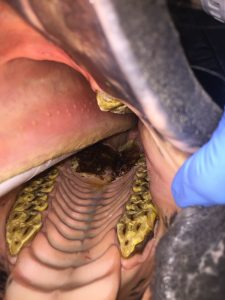Dressage diva dreams
June 9, 2022
Equine veterinary hospital Comments Off on Standing tieback surgery for ‘roarers’
22
15
18
Gemma’s owner, Kaye, had big plans for her beautiful Dutch riding pony. Kaye had owned Gemma since she was 3 years old and was drawn to her for her potential, trainability and general good attitude. She was on the road to achieving her competition goals, but then, over two years ago, Gemma started displaying fatigue and exercise intolerance signs. Under the advice of various vets, she tried lots of different management strategies, including rest, to get her really fit or don’t ride her on the bit. Despite all efforts, Gemma could not be ridden without severely huffing and puffing. She definitely could not do a whole dressage test. Otherwise bright and alert, Gemma had a great work ethic, but Kaye had a feeling something was wrong.
Kaye brought Gemma to CEC to undergo a full respiratory workup which included a resting endoscopy of the upper airway; this didn’t show any abnormalities. The only way to see what was happening in Gemma’s airways when she was at work was to perform an endoscope on the treadmill. This diagnostic procedure is most commonly performed on racehorses to investigate causes of poor performance and is used less commonly in other breeds.
Any horse undergoing this procedure must be acclimatised to the treadmill. Gemma was not too fond of the treadmill and the scope simultaneously, but with time and patience from the nursing staff, we were able to perform the procedure and diagnose “rostral billowing of the soft palate”. This abnormality is where the soft palate (usually positioned below the epiglottis and fairly rigid) billows up (a bit like a bedsheet when thrown up in the air when making your bed). In this case, the soft palate was severely obscuring the entrance to the trachea (windpipe), and poor Gemma could not get enough air into her lungs to even have a simple workout.
Considering her age and the fact that Gemma had already been rested for a long time, further prolonged rest was unlikely to resolve the problem. A surgical treatment known as “thermal palatoplasty” was offered and subsequently performed. This surgery involves cauterising the underside of the front of the soft palate to make it stiffen with time. The procedure is well-tolerated, and horses can eat and drink normally after surgery and do not show any signs of pain. Gemma had the procedure performed and was discharged home the next day.
Follow up has revealed great success in that Gemma is now back in full work and is competing. She has won several tests and a championship and has recently started in medium dressage. We are so happy for Gemma and Kaye. A relatively simple procedure effectively means that Gemma can have a successful career doing what she enjoys.




0 Comments